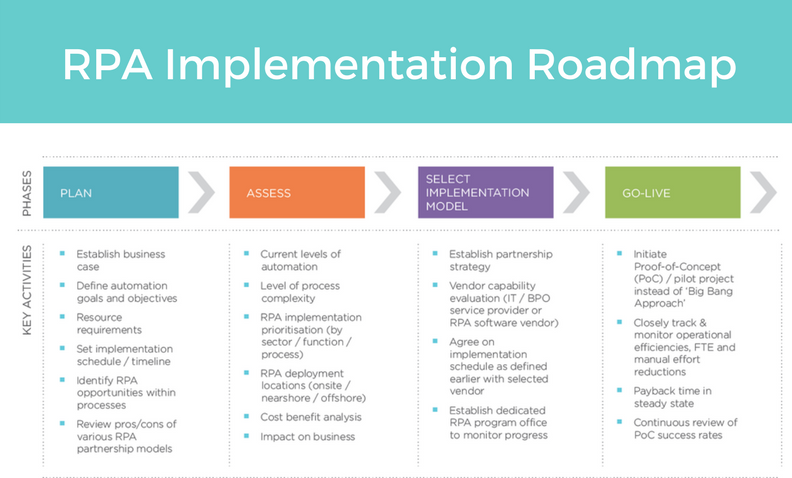ROBOTIC PROCESS AUTOMATION (RPA) AS AN APPLICATION/TOOL
The “tool” can be configured to capture and interpret actions of existing applications used in various business processes, just as a human operator would do. These tools can mimic human actions without associated errors. The most important attribute of these tools is audit and logging. Any action or step taken by them can be logged and audited. Human resources can watch and perform surveillance of each step and action of these tools. This feature also differentiates Robotic Process Automation from Straight Through Processing (STP) tools, where there is no visibility to human eyes of the steps/action taken by an automated process. Straight-through processing is an automated process performed purely through electronic transfers with no manual intervention.
Automated surveillance mechanisms widely monitor human actions and steps. The Converse will happen in a robotic process automation process.
Robotic process automation solutions use robotic software to automate a task. They mimic the actions of human beings and are relatively less intrusive. By taking over repetitive, structured, and rules-dependent tasks, RPA automates processes at a large scale. Once the RPA tool has been trained or configured with well-defined business rules, it can then perform the functions automated exactly as a human operator would. These may include processing bulk transactions, manipulating data, triggering real-time alerts or responses, creating audit trails, and communicating seamlessly with other enterprise systems.
- RPA systems are non-intrusive automation applications that do not require technical integration with other systems.
- They work at the graphical user interface level and do not need much, if any, IT support.
- And by replacing significant human error, they deliver substantially enhanced productivity.
If you look around, there is a glut of information on Intelligent Automation/ Hyperautomation and Robotic Process Automation. Businesses still find it challenging to understand how automation can benefit them.
Can Artificial Intelligence (AI)-powered tools be part of their business and operational environments and contribute to business growth? The answer is yes!
Intelligent Automation and Robotic Process Automation, which includes machine learning, Machine Vision, and Natural Language Processing (NLP), are easily accessible, easy to deploy, faster, and more efficient than many companies choose to believe. At the same time, Intelligent Automation and Robotic Process Automation are rapidly becoming a part of mainstream business operations, empowering teams and departments to execute tasks faster and more efficiently.
According to Gartner, by the end of 2022, 90% of large and huge enterprises will deploy some form of RPA in their work process. Getting started on RPA solutions is easy. While many businesses are interested in leveraging RPA’s potential to get ahead of the digital transformation curve, they remain unsure how to identify processes where these solutions can be deployed.
ROBOTIC PROCESS AUTOMATION VS INTELLIGENT AUTOMATION
Depending on the needs of the client, robotic process automation and intelligent automation provide customized solutions to automate business operations. RPA helps businesses automate normal, routine tasks that require little to no decision-making. It interacts with applications and systems like humans do. Businesses can leverage this technology to automate data entry, data extraction, and report preparation.
IA blends RPA with Artificial Intelligence (AI) such as machine learning and natural language processing, to cope with more complicated operations that require judgment or reasoning from intelligent machines. Along with more typical data analysis activities, IA enables the automation of complex analytic jobs such as customer service support and economic forecasting.
How is RPA transforming business operations?
By harnessing the power of Robotic Process Automation, businesses can unlock remarkable advantages, such as:
Cost efficiency
Robotic process automation could decrease operational costs by 25-50%. As robots are able to perform 24/7 with no vacation time, businesses can invest more time in less manual labor and get evident results from their investments. With RPA, many organizations have found that they can recover their initial cost within a relatively short amount of time - ultimately leading to increased net gains.
Consistency
Robots provide a consistent approach to activities, ensuring the same flawless performance each time. This non-invasive technology doesn't disrupt built-in systems and offers a safe way to perform tasks perfectly every single time.
Enhanced Workforce Efficiency
Robotic Process Automation provides opportunities to enable both robots and humans to do what they are best at. Employees can dedicate more time to client/customer interaction and relationship management by allowing robots to perform routine tasks. Doing so results in increased customer satisfaction, ultimately leading to better business.
REQUIREMENT OF ROBOTIC PROCESS AUTOMATION IN 5 SCENARIOS
Below, we present five scenarios that can help identify these activities and processes that can be considered for Robotic Process Automation.
The Volume Of Repetitive Tasks
A major application of RPA is the automation of high-volume, repetitive tasks. RPA finishes tasks quickly while ensuring high levels of accuracy. Mental fatigue creeps in when humans spend long hours repeating the same task. Robotic automation can handle voluminous repetitive tasks without complaining of fatigue, distraction, or boredom.
Automating structured and unstructured data becomes possible with AI added to the equation. For instance, a European real estate company uses AI, machine learning, and computer vision to compare large volumes of data on property records and geographical images. The resultant machine-derived conclusions help employees identify discrepancies and discover insights, increasing their efficiency by 80%.
Addressing Human Errors In Processes
Usually, automated tasks involve processing a lot of data, which people often find challenging and thus are prone to many human errors. Robotic Process Automation helps in bringing down the possibility of error in business processes, activities, and transactions. This includes incorrect data entry, skipped or incomplete steps in process-driven tasks, and rule application errors. It ensures that decisions dependent on data accuracy and interpretation are not compromised.
Fraud Detection Or Internal Audits
As outlined above, Robotic Process Automation can be used in various business scenarios, but it adds incremental value in fraud detection and internal audits. Organizations are actively implementing RPA solutions in the internal security management system with robotic software assisting humans in time-consuming background checks and fraud investigations. Financial fraud monitoring, tracking, and investigations can also be made quickly during day-to-day financial transactions. Machine learning is combined with RPA to observe behavioral patterns, analyze and detect hidden correlations in data, and identify and flag possible fraud scenarios in real-time.
Improving Customer Experience Through Intelligent Automation
Deploying Robotic Process Automation can make customer service agents more effective and customer service efficacious. With consumers increasingly contacting organizations over various platforms, more than ever before, it’s becoming important for businesses to make every contact point an opportunity for a great brand experience. RPA allows customer service staff to hand over their repetitive and time-tasking processes and tasks, helping them elevate their skills and nurturing customer relationships. With routine tasks taken care of, empathy and rapport with the customer become the focus of customer service agents.
Automation of Big Data
According to McKinsey: “The amount of data in our world has been exploding, and analyzing large data sets, so-called big data will become a key basis of competition, underpinning new waves of productivity growth, innovation, and consumer surplus.” If Big Data is a gold mine, RPA is an invaluable tool to extract meaning from Big Data. Businesses can bring together RPA and Big Data to identify anomalies within business processes and streamline these hiccups from within their operations.
For instance, online retailers collect data from multiple sources about their customers’ buying habits. These could include preferred price range, product and brand choices, and buying decisions for special offers. By procurement robotics process automation and analyzing the vast data sets, the information can be used to revise the company’s offerings, customizing them and focusing on individual customer needs.
So is your business an ideal candidate for RPA? It is if you work with large amounts of structured data, has rules-based business processes, and high-volume repetitive-task workflow. If your answer is yes, get ready to make the RPA transition.
Get started with your RPA Journey today!
RPA technology best suits highly repetitive, rule-based activities and processes typically associated with high volume, transaction-oriented back office processes.
RPA platforms have the capability to automate a broad range of processes in key functions, including finance and accounting processes, HR, procurement, logistics, customer experience management, and supply chain
Get started with your RPA Journey today!

RPA technology is best suited for highly repetitive, rule-based activities and processes which are typically associated with high volume, transaction oriented back office processes.
RPA platforms have the capability to automate a broad range of processes in key functions including finance and accounting processes, HR, procurement, logistics, customer experience management and supply chain
Topic: Robotic Process Automation, RPA

